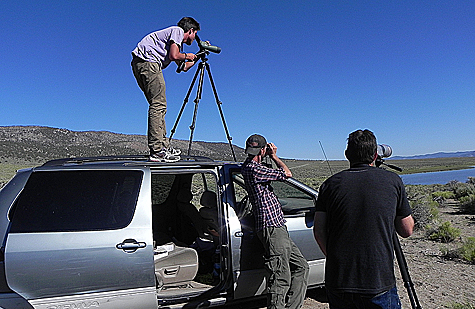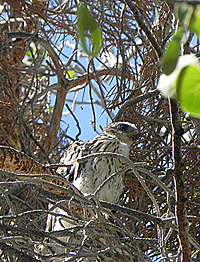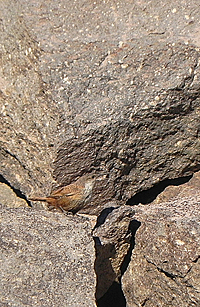
This post was written by Oliver James, 2011 Birding Intern.
If you had chosen to visit the small town of Lee Vining at 2:30 in the morning on July 12th, you would have found a peculiar sight in the Mono Lake Committee’s Field Station alley: four intrepid souls huddled together under the three-quarter moon armed to the teeth with binoculars. A very peculiar ritual was about to begin wherein four birders attempt to identify as many different species of birds as they can within a defined geographic area in a full 24-hour period. Every second counts and there are no stops for lunch.

The birders were none other than Justin Hite (Mono Basin naturalist), Oliver James (Committee Birding Intern), Nora Livingston (PRBO Conservation Science Field Technician), and Chris McCreedy (PRBO Conservation Science biologist). The playing field was Mono County. The existing record was 135 species set in 1999 by a crack team lead by Kristie Nelson, longtime Mono Basin bird guru.
At 4:00am, and with two more hours left until sunrise, the sleepy team was crossing over the Mono-Inyo County line into the Fish Slough Area of Environmental Concern. As if forewarned of their arrival, a Short-eared Owl was waiting on the Mono side of the line. Bird number one. 135 more to go. As expected, this southern oasis produced a handful of additional birds in the early pre-dawn light that would not be possible anywhere else in the county: Le Conte’s Thrasher, Blue Grosbeak, and Black-throated Sparrow. With the list creeping towards 35 species, the sun was creeping over White Mountain and the clock was ticking. Time to go.

After Chris spotted a Golden Eagle surveying its domain on an outcropping near Newspaper Rock, the team moved north through Chalfant Valley, adding nesting Swainson’s Hawks and an Ash-throated Flycatcher to the list. The town of Benton was quick to reveal several rowdy Great-tailed Grackles and further up the road the famed Wild Rose Canyon did not disappoint: singing Virginia’s Warbler and a Red-naped Sapsucker tending the same nest as a Red-breasted (hybrid babies!) practically flew onto the day list.
Mono County’s second largest body of water, Crowley Lake Reservoir, was windy and bountiful as always. Justin spotted a Black Tern cruising the far shore as a Long-billed Curlew probed nearby on the shore. But wait … what’s this? What had initially passed off as another Willet poking its head out above the reeds was actually a big chicken head! A Greater Sage Grouse! On the playa!
High noon saw the team scouring the high-elevation red fir forest above Mammoth. In the thin air at 9,000 feet both Kinglet species were busy competing for air time. Unable to elude Nora’s sharp eyes, a nearby Pine Grosbeak seemed unperturbed, if not completely at peace, in his mountain retreat.

It wasn’t until 3:38pm that the team crossed into the Mono Basin proper. Regulars like Yellow Warbler, Brewer’s Sparrow, and Osprey waited patiently to make their presence known, happy to know that, on this day, their intrinsic value was tantamount to that of the flashy male Indigo Bunting at the “Warbler Thicket” south of the Mono Inn.
Staring into the setting sun over Bridgeport Reservoir the team was able to detect the three Sandhill Cranes lounging among the heifers to the southwest. With only a few minutes of daylight left, the team raced the sun to Matterhorn Mountain. A shot in the dark for Common Merganser at Twin Lakes: just when it seemed as if the list had topped out, Chris willed a drake out from behind the boat launch. Bird number 150.
After a downright leisurely drive back over Conway Summit, the team ran into its first pitfall of the day: loitering in the pitch black outside the gate at Conway Ranch, a Mono County sheriff arrived to ask, frankly, what four people with binoculars were doing out in the middle of nowhere at 11:00pm. Much to the team’s surprise and delight, they left the ranch without a telling off, but instead a tip for on a “much better place” to look for Long-eared Owls than Conway Ranch! As it turns out, police are good at Big Days too.
And so, 22 hours and 375 miles later, that is how the Mono County Big Day Record came to be broken: 150 species is now the number to beat (see the complete list here). The team would like to salute the Mono County Sheriff’s Department and all the county personnel who keep the dirt roads in Mono County accessible for Oliver’s Toyota minivan.

This is an awesome total for an inland Big Day. My best for a coastal county is 163 species in SLO Co. in the Spring of 1998.
Congrats on your team’s stupendous achievement! It’s very inspiring. I hope to visit Mono Lake next year — last time I went I was very young and don’t remember that trip at all (and definitely was not appreciative then of birds). Will make an effort to enjoy birding when I go.